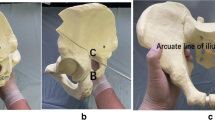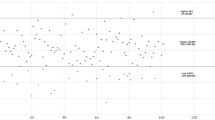Abstract
Background
Although pelvic osteotomy in children has been effective in re-establishing containment of the hip joint, its impact on hip joint development with respect to acetabular coverage is ill defined.
Purpose
The purpose of this study is to determine the prevalence of acetabular overcoverage in patients who had pelvic osteotomy during childhood and its impact on patient function.
Patients and Methods
Between 1980 and 2008, all patients who had a pelvic osteotomy done at our institution for non-neuropathic hip dysplasia (DDH) or secondary to Legg–Calvé–Perthes disease (LCP) prior to skeletal maturity were reviewed. A clinical assessment and the WOMAC, UCLA Activity Score, Marx activity score, and SF-36 quality-of-life questionnaires were completed. A standardized AP pelvic X-ray was performed to determine the acetabular coverage, signs of retroversion, and degenerative changes.
Results
Twenty-eight patients (32 hips) were identified, of which 14 (9 DDH, 5 LCP) agreed to participate. Impingement sign was positive in eight patients (six DDH, two LCP). Crossover and ischial spine signs were each present in ten hips. Tonnis grades were: 0 in 1 hip, 1 in 10 hips, 2 in 2 hips, and 3 in 1 hip. The mean Tonnis angle was 11.6 ± 8.6°. The mean CE angle was 24.0 ± 15.9° with six hips having a CE angle <20° and one hip with a CE angle >40°. There was no correlation between crossover sign or ischial sign and Tonnis grade (p = 0.739), hip pain (p = 0.520), or impingement sign (p = 1.00).
Conclusions
Acetabular overcoverage is common in patients who underwent pelvic osteotomy during childhood. No correlation was identified between retroversion and hip pain in our patient cohort.

Similar content being viewed by others
References
Allen DJ, Beaule PE, Ramadan O, Doucette S. Prevalence of associated deformities and hip pain in patients with cam type femoroacetabular impingement. J Bone Joint Surg. 2009;91B:589-594.
Amstutz HC, Thomas BJ, Jinnah R, Kim W, Grogan T, Yale C. Treatment of primary osteoarthritis of the hip. A comparison of total joint and surface replacement arthroplasty. J Bone Joint Surg Am. 1984;66:228-241.
Beck M, Kalhor M, Leunig M, Ganz R. Hip morphology influences the pattern of damage to the acetabular cartilage: femoroacetabular impingement as a cause of early osteoarthritis of the hip. J Bone Joint Surg. 2005;87B:1012-1018.
Bellamy N, Buchanan WW, Goldsmith CH. Validation study of WOMAC: a health status instrument for measuring clinically important patient relevant outcomes following total or knee arthroplasty in osteoarthritis. J Orthop Rheumatol. 1988;1:95-108.
Bellamy N, Buchanan WW, Goldsmith CH, Campbell J, Stitt LW. Validation study of WOMAC: a health status instrument for measuring clinically important patient relevant outcomes to antirheumatic drug therapy in patients with osteoarthritis of the hip or knee. J Rheumatol. 1988;15:1833-1840.
Bohm P, Brzuske A. Salter innominate osteotomy for the treatment of developmental dysplasia of the hip in children: results of seventy-three consecutive osteotomies after twenty-six to thirty-five years of follow-up. J Bone Joint Surg Am 2002 84-A: 178-186.
Clohisy JC, Nunley RM, Carlisle JC, Schoenecker PE. Incidence and characteristics of femoral deformities in the dysplastic hip. Clin Orthop Relat Res. 2009;467:128-134.
Cobb J, Logishetty K, Davda K, Iranpour F. Cams and pincer impingement are distinct, not mixed: the acetabular pathomorphology of femoroacetabular impingement. Clin Orthop Relat Res. 2010;468:2143-2151.
Dora C, Mascard E, Mladenov K, Seringe R. Retroversion of the acetabular dome after Salter and triple pelvic osteotomy for congenital dislocation of the hip. J Pediatr Orthop B. 2002;11:34-40.
Giori NJ, Trousdale RT. Acetabular Retroversion is associated with osteoarthritis of the hip. Clin Orthop. 2003;417:263-269.
Grudziak JS, Ward WT. Dega osteotomy for the treatment of congenital dysplasia of the hip. J Bone Joint Surg Am. 2001;83-A: 845-854.
Haidar RK, Jones RS, Vergroesen DA, Evans GA. Simultaneous open reduction and Salter innominate osteotomy for developmental dysplasia of the hip. J Bone Joint Surg Br. 1996;78:471-476.
Huang SC, Wang JH. A comparative study of nonoperative versus operative treatment of developmental dysplasia of the hip in patients of walking age. J Pediatr Orthop. 1997;17:181-188.
Ito H, Ooura H, Kobayashi M, Matsuno T. Middle-term results of Salter innominate osteotomy. Clin Orthop Relat Res. 2001;156-164.
Jamali AA, Maldenov K, Meyer DC, Martinez A, Beck M, Ganz R, Leunig M. Anteroposterior pelvic radiographs to assess acetabular retroversion: high validity of the "cross-over-sign". J Orthop Res. 2007;25:758-765.
Kalberer F, Sierra RJ, Madan SS, Ganz R, Leunig M. Ischial spine projection into the pelvis : a new sign for acetabular retroversion. Clin Orthop Rel Res. 2008;466:677-683.
Kim WY, Hutchinson CE, Andrew JG, Allen PD. The relationship between acetabular retroversion and osteoarthritis of the hip. J Bone Joint Surg Br. 2006;88:727-729.
Lamontagne M, Kennedy MJ, Beaule PE. The Effect of Cam FAI on Hip and Pelvic Motion during Maximum Squat. Clin Orthop Rel Res. 2009;467:645-650.
LeBel ME, Gallien R. The surgical treatment of teratologic dislocation of the hip. J Pediatr Orthop B. 2005;14:331-336.
Leunig M, Beaule PE, Ganz R. The concept of femoroacetabular impingement: current status and future perspectives. Clin Orthop Rel Res. 2009;467:616-622.
Li PL, Ganz R. The morphology of congenital acetabular dysplasia. One in six is retroverted. Clin Orthop Rel Res 2003 416: 245-253.
Marx RG, Stump TJ, Jones EC, Wickiewicz TL, Warren RF. Development and evaluation of an activity rating scale for disorders of the knee. Am J Sports Med. 2001;29:213-218.
Mast JW, Brunner RL, Zebrack J. Recognizing acetabular version in the radiographic presentation of hip dysplasia. Clin Orthop Rel Res. 2004;418:48-53.
Mayo KA, Trumble SJ, Mast JW. Results of periacetabular osteotomy in patients with previous surgery for hip dysplasia. Clin Orthop Rel Res. 1999;363:73-80.
Murphy SB, Ganz R, Muller ME. The prognosis in untreated dysplasia of the hip. A study of radiographic factors that predict the outcome. J Bone Joint Surg. 1995;77A:985-989.
Myers SR, Eijer H, Ganz R. Anterior femoroacetabular impingement after periacetabular osteotomy. Clin Orthop Rel Res. 1999;363:93–99.
Nehme A, Oakes D, Perry MJ, Hawatmeth SI, Trousdale RT. Acetabular morphology in bladder exstrophy complex. Clin Orthop Relat Res. 2007;458:125-130.
PEMBERTON PA. PERICAPSULAR OSTEOTOMY OF THE ILIUM FOR TREATMENT OF CONGENITAL SUBLUXATION AND DISLOCATION OF THE HIP. J Bone Joint Surg Am. 1965;47:65-86.
Reynolds D, Lucas J, Klaue K. Retroversion of the acetabulum. A cause of hip pain. J Bone Joint Surg. 1999;81B:281-288.
Robb CA, Datta A, Nayeemuddin M, Bache CE. Assessment of acetabular retroversion following long term review of Salter’s osteotomy. Hip International. 2009;19:8-12.
Salter RB. Role of innominate osteotomy in the treatment of congenital dislocation and subluxation of the hip in the older child. J Bone Joint Surg Am. 1966;48:1413-1439.
Salter RB. Innominate osteotomy in the treatment of congenital dislocation of the hip. J Bone Joint Surg. 1961;43B:518-539.
Sankar WN, Flynn JM. The development of acetabular retroversion in children with Legg-Calvé-Perthes disease. J Pediatr Orthop. 2008;28:440-443.
Siebenrock KA, Kalbermatten DF, Ganz R. Effect of pelvic tilt on acetabular retroversion: a study of pelves from cadavers. Clin Orthop Rel Res. 2003;407:241-248.
Steel HH. Triple osteotomy of the innominate bone. J Bone Joint Surg. 1973;55A:343-350.
Sutherland DH, Greenfield R. Double innominate osteotomy. J Bone Joint Surg Am. 1977;59:1082-1091.
Thomas SR, Wedge JH, Salter RB. Outcome at forty-five years after open reduction and innominate osteotomy for late-presenting developmental dislocation of the hip. J Bone Joint Surg Am. 2007;89:2341-2350.
Tonnis D. Normal Values of the hip of the Hip Joint for the evaluation of x-rays in children and adults. Clin Orthop. 1976;119:39-47.
Tonnis D, Heinecke A. Acetabular and femoral anteversion: relationship with osteoarthritis of the hip. J Bone Joint Surg. 1999;81A:1747-1770.
van Bergayk AB, Garbuz DS. Quality of life and sports-specific outcomes after Bernese periacetabular osteotomy. J Bone Joint Surg. 2002;84B:339-343.
Ware JE, Snow KK, Kosinski M, Gandek B. SF-36 Health Survey: Manual and Interpretation Guide. 1993;
Wiberg G. Studies on dysplastic acetabula and congenital subluxation of the hip joint: with special reference to teh complication of osteoarthritis. Acta Chir Scand. 1939;83:
Yasunaga Y, Yamasaki T, Matsuo T, Ishikawa M, Adachi N, Ochi M. Crossover sign after rotational acetabular osteotomy for dysplasia of the hip. J Orthop Sci. 2010;15:463-469.
Disclosures
The authors declare that they have no conflict of interest. Each author certifies that he or she has no commercial associations (e.g., consultancies, stock ownership, equity interest, patent/licensing arrangements, etc.) that might pose a significant conflict of interest in connection with the submitted article.
Each author certifies that his or her institution approved the human protocol for this investigation that all investigations were conducted in conformity with ethical principles of research, and that informed consent for participation in the study was obtained.
Author information
Authors and Affiliations
Corresponding author
Additional information
Level of Evidence
Prognostic study, level IV (case series). See the guidelines for authors for a complete description of levels of evidence.
Rights and permissions
About this article
Cite this article
Al-Moussa, S., Moroz, P. & Beaulé, P.E. Effect of Pelvic Osteotomy in the Skeletally Immature on Acetabular Coverage. HSS Jrnl 8, 235–239 (2012). https://doi.org/10.1007/s11420-012-9286-8
Received:
Accepted:
Published:
Issue Date:
DOI: https://doi.org/10.1007/s11420-012-9286-8




